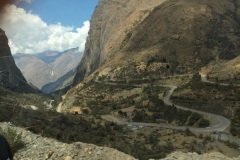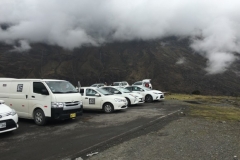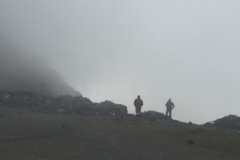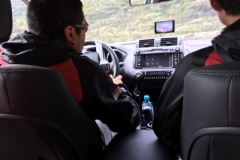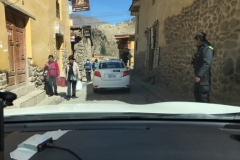Questions raised by the mountain roads in the Andes.
Departing from the ancient capital of Cusco, sometimes called the belly button of the Inca Empire, the team once again drove into the Andes. Spending day after day ascending mountain slopes brought a range of questions to the fore. What bothered Morimoto from the Vehicle Technology Development Division was the gear ratio going from first to second in a Yaris. But when he asked Joel from the local crew if he thought it was a problem, Joel did not express dissatisfaction. Cars on the road in Peru frequently overtake slow-moving trucks. You would think that cars without a lot of power like the Yaris would have a hard time, but apparently locals don’t think it’s so bad. Adachi, the assistant team leader, had the same question. He thinks drivers might make up for the lack of power with their driving technique. “Take the fact that you don’t see mirrors put up around curves in Peru. Under these conditions, drivers are aware of accidents and are in the habit of communicating their intent to other drivers. It seems like they communicate with each other when they overtake vehicles too.”
For Morimoto, who was trying to find out what dissatisfied local drivers, Toyotas had an unexpectedly good reputation. But he was taken by surprise when he heard that wearing a watch got in the way when the driver changed seat positions. The steering wheel is on the right in Japan, and when inspecting vehicles, Toyota staff cannot wear a watch to prevent any scratches. Morimoto took to heart the idea that you have to question even the things you have been taught to take for granted.
Finding the driving performance demanded in Peru.
When Eduard from the local crew heard that one driver’s license classification in Japan is limited to automatic vehicles only, he laughed and asked quizzically, “Why, Japanese?” The ratio of automatic to manual transmission vehicles in Peru is 3:7, and one reason is price. There’s the impression that older technology is easier to fix on one’s own when something goes wrong.
You almost never see Priuses in Peru. This can be largely attributed to people believing that electronic parts are prone to breakdowns, as well as the fact that diesel engines make up about 50% of the Peruvian market. Diesel is cheaper than gasoline and performs well at low rpm. LPG vehicles running on domestically produced natural gas are also a common sight. We heard that many taxis buy new gasoline-engine cars and then immediately convert them to run on LPG.
Miyazaki from the Vehicle Technology Development Division, who was previously involved in developing the Land Cruiser, was disappointed to not see many of them in Peru. “People want a car that’s even ten thousand yen cheaper.” This impression became stronger with each city they visited.
The things we wanted to affirm driving around the world.
The old road leading to Arequipa, a former capital of Peru, was a rough dirt track that used to be part of the Dakar Rally route. Two engineers were basking in a glow of satisfaction in direct contrast to the treacherous road—Kunimasa from the Body Design Division and Owatari from the Drive Train System Managing Division. When asked why they were participating in the Drive Project, they both said the same thing: They wanted to get to know cars better. Even though Kunimasa’s profession was design, he would make a wry face and say he was still learning. He is aware of how easy it is to lose sight of the fact that he’s involved in making cars when he doesn’t ride in competitors’ cars and doesn’t readily get feedback from owners in his job. Owatari feels the same. His development work is typically based on information gained from car markets, but this trip was the first time he was able to experience many things firsthand. He found out a lot, like how a 4.0-liter Prado performed surprisingly poorly in the highlands, while diesel engines ran surprisingly well even at high elevations. The realizations from genchi-genbutsu were very much being etched into the team members’ minds.
Old Toyotas are zipping around Bolivia.
After entering Bolivia, the team encountered one old Toyota after another on their way to Salar de Uyuni, the largest salt flat in the world. They found a weathered HiAce in an arid rural town with an odometer that read 999,999 km. The team was taken by surprise when the owner said that he drove 600 km a day, and when their local guide told them that was typical for this area, they were left speechless.
They encountered a used Noah in Salar de Uyuni that was being employed as a shared-ride taxi. Used cars imported from Japan cannot be driven as is—they first need to have their steering wheel switched to the left side. The team was full of gratitude at seeing Toyotas kept running for so long, but they were a little concerned about safety. Hayakawa from the Vehicle Technology Development Division commented, “I want to go to a body shop and see what their process is and check on safety.” The team very quickly saw the demand for inexpensive, durable cars in Bolivia. What features were needed, and what could be left out, in delivering “ever-better cars” to South America? The members searched for their own answers as they drove across the white salt flats that stretched to the horizon.
